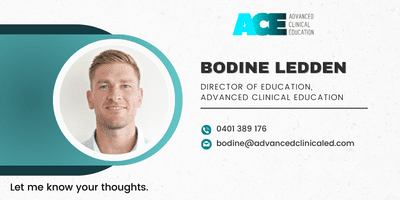Are you certain?
How certain are we about the causes we identify? Before labelling something as the cause, have we genuinely explored all possibilities?
We often take the path of least resistance, seeking confirmation for our assumptions rather than challenging them. For example, if a patient presents with back pain and we examine them through a structural lens, we might quickly attribute the pain to structural issues such as pelvic alignment, leg length, spinal curvature or posture.
As clinicians, we often feel responsible for giving a definitive answer, explaining the reason, or identifying a cause, even when the reality is rarely that straightforward. The responsibility of pinpointing the cause of a complex, multifaceted experience like pain may not even be possible.
Have we lost sight of what truly matters to patients? Are they really seeking a specific pathoanatomical label, or do they simply want to live pain-free?
Perhaps a more beneficial approach is to focus on what life without pain could look like rather than fixating on finding a definitive problem. After all, how certain are we that our explanations for their pain are accurate?
Many of us rely on experience: “I’ve seen this a hundred times; I know what’s happening.” But pain is highly individual, it is as unique to the person as a fingerprint.

Consider this perspective…
Imagine two clinicians locked in a debate. Unable to reach a consensus, they bring the case to a professor. The professor listens to the first clinician, nods, and says, “You’re right.” He then hears the second clinician’s viewpoint, nods again, and says, “You’re also right.” The professor’s assistant, looking confused, asks, “How can they both be right?” The professor reflects for a moment and responds, “You’re right, too.”
Science often resembles this story. If we only look through one lens, that’s all we see. When we maintain an open mind and consider different perspectives, we reduce bias and perhaps take a more holistic view. Neither science nor the experience of pain is black and white. But its ok to live in the grey.
In disagreements, it’s rare for one party to be completely right and the other entirely wrong. Usually, both sides have some validity. Being open to multiple perspectives is essential.
Zoom out…
Can we support our perspective with reliable scientific evidence, clinical experience, anatomical understanding, physiology, pathophysiology, and considerations of a person’s biology, social context, past experiences, environment, lifestyle, beliefs, and expectations?
And after examining all these factors, would we still be open to another viewpoint and willing to change?
Maybe it’s okay not to have a definitive cause. Perhaps the answer lies in fostering positive change, empowering patients along their journey, and supporting them in understanding their pain-related behaviours. By recognising what precedes and follows these behaviours, it allows us as clinicians and our patients to understand the function of said behaviours. Exploring mindfulness for people in pain can improve the locus of control and allow the person in pain to be in control and not let pain control the person. Creating this shift in mindset can lay the groundwork for meaningful behavioural change.
It is important to remember that change comes from within, help your patients take control of what their future will look like and move beyond pain.


